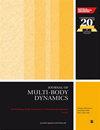Design of a tracking controller for autonomous articulated heavy vehicles using a nonlinear model predictive control technique
IF 1.9
4区 工程技术
Q3 ENGINEERING, MECHANICAL
Proceedings of the Institution of Mechanical Engineers Part K-Journal of Multi-Body Dynamics
Pub Date : 2024-03-07
DOI:10.1177/14644193241232353
引用次数: 0
Abstract
This article proposes a design of a tracking controller for autonomous articulated heavy vehicles (AAHVs) using a nonlinear model predictive control (NLMPC) technique. Despite economic and environmental benefits in freight transportation, articulated heavy vehicles (AHVs) exhibit poor directional performance due to their large sizes, multi-unit vehicle configurations, and high centers of gravity (CGs). AHVs represent a 7.5 times higher risk of traffic accidents than single-unit vehicles (e.g. rigid trucks, cars, etc.) in highway operations. Human driver errors cause about 94% of traffic collisions. However, little attention has been paid to autonomous driving control of AHVs. To increase the safety of AHVs, we design a novel NLMPC-based tracking controller for an AHV, that is, a tractor/semi-trailer combination, and this tracking controller is distinguished from others with the feature of controlling both the lateral and longitudinal motions for both the leading and trailing units. To design the tracking controller, a new prediction AHV model is developed, which represents both the lateral and longitudinal dynamics of the vehicle and captures its rearward amplification feature over high-speed evasive maneuvers. With the proposed tracking controller, the AAHV tracks the predefined reference path and follows a planned forward-speed scheme. Co-simulation demonstrates the effectiveness and robustness of the proposed NLMPC tracking controller.利用非线性模型预测控制技术为自主铰接式重型车辆设计跟踪控制器
本文利用非线性模型预测控制(NLMPC)技术,提出了自主铰接式重型车辆(AAHV)跟踪控制器的设计方案。尽管铰接式重型车辆(AHVs)在货物运输中具有经济和环境效益,但由于其体积庞大、多单元车辆配置和高重心(CGs),其定向性能较差。在高速公路运营中,铰接式重型车辆发生交通事故的风险是单单元车辆(如硬质卡车、轿车等)的 7.5 倍。人为驾驶失误造成的交通碰撞事故约占 94%。然而,人们很少关注自动衡器车的自动驾驶控制。为了提高自动驾驶汽车的安全性,我们为自动驾驶汽车(即牵引车/半挂车组合)设计了一种基于 NLMPC 的新型跟踪控制器。为了设计跟踪控制器,开发了一个新的预测 AHV 模型,该模型同时代表了车辆的横向和纵向动态,并捕捉到了车辆在高速规避机动时的后向放大特性。利用所提出的跟踪控制器,AAHV 可跟踪预定的参考路径,并遵循计划的前进速度方案。联合仿真证明了所提出的 NLMPC 跟踪控制器的有效性和鲁棒性。
本文章由计算机程序翻译,如有差异,请以英文原文为准。
求助全文
约1分钟内获得全文
求助全文
来源期刊

CiteScore
4.10
自引率
11.10%
发文量
38
审稿时长
>12 weeks
期刊介绍:
The Journal of Multi-body Dynamics is a multi-disciplinary forum covering all aspects of mechanical design and dynamic analysis of multi-body systems. It is essential reading for academic and industrial research and development departments active in the mechanical design, monitoring and dynamic analysis of multi-body systems.
 求助内容:
求助内容: 应助结果提醒方式:
应助结果提醒方式:


